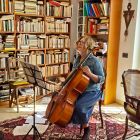The pick of Lazio
What is the most attractive place in Lazio, besides Rome? And the next? And the third? Asked where they would send a friend venturing into Lazio for the first time, ten interviewees came up with answers that either astonishingly coincided or were strikingly personal.
The number one prize went by a big margin to a place allegedly founded by the Spartans but then abandoned by its superstitious inhabitants in deference to invading snakes. Later, the Emperor Tiberius turned one of its coastal caves into a palace of pleasures set on one of the two sweeping beaches enjoyed today by more people than ever before. Sperlonga, exclaimed Claudio Mastrella, customer manager at an IntesaBci bank branch, is a little Capri. The water is stupendous and the town on its steep spur poking into it is bello, bello, bello! He would also press a friend to scout around Hadrians Villa at Tivoli.
Among other fans of Sperlonga was Ian Winter, deputy teaching centre manager at the British Council, but he also had a word for Gaeta further south. Because of the American naval base there, the descriptions of it are awful and put me off for a long time. Then I went there and loved it. Perhaps echoing the thoughts of many, he added: When I think of Lazio, I always think of the coast.
Lazio also suggested the sea to Anna Delponte, spokesperson at the Rome opera house. For her the ideal spot in the region was the popular island of Ponza, reached by ferry from Anzio and Formia. On the mainland, what she adored most was the small mountain town of Cervara di Roma, near Subiaco to the east of Rome, which, at 1,053 m, is the second highest in the province of Rome, with a stunning panorama. Artists have covered its walls with their pictures. Its charming. She was the only one to pick this corner of Lazio.
Roberto Gruppo, restaurant owner and forceful voice among the residents of Ostia, vowed he would push any friend of his straight off to Ostia Antica, which for him embraced the most beautiful Roman remains in the world. He would also counsel the Castelli Romani, the picturesque hill towns to the south of Rome. The Castelli were also the loyal choice after Sperlonga of another in the same trade, Davide Anisetta, ruler of Bucci, a restaurant in Castel Gandolfo offering a stupendous view of Lake Albano from the lip of its extinct volcano.
Other people questioned would all despatch friends to rugged northern Lazio to view the deserted homeland of the defence-conscious Etruscans, with their liking for lonely spurs and bluffs, plunging ravines and sinister burial places. First to air passion for this highly atmospheric terrain was Roberta (No surname please!) from the Roman tourist board office near Termini station. She plumped for the vast area with mediaeval Viterbo as its pivot, quoting the stately Palazzo Farnese at Caprarola and, towards the coast, the Etruscans painted tombs at Tarquinia and their forbidding city of the dead at Cerveteri.
Friends of Kay McCarthy, the singer of Irish ballads, would get packed off to walled Viterbo itself. Its a city in the true sense, very human with a lot to tell. In the fascinating mediaeval quarter of S. Pellegrino its like going back in time. Theres a baroque music festival in October. But her softest spot was for Capranica on Via Cassia, sitting on a long finger of tufa between two deep valleys. Its simple with a lovely romanesque Franciscan church. There are concerts. Its a hazelnut centre.
Another musician, poet and actor too, was Angelo Sebastianini, the versatile talent behind the Tempietto cycle of summer concerts at Villa Torlonia and Teatro di Marcello. His secret place in Lazio was not far off, namely Falerii Novi near Civita Castellana, described in a guide book as a rare and splendid example of a fortified provincial Roman town, with two kilometres of walls, from the third century BC. Another special place for Sebastianini was the great mediaeval monastery of Farfa in the Sabine hills. Its the aura of spirituality about it, a very fertile ground for anybody with a creative turn of mind.
Then, a coincidence. The lightning first choice of Renato Casoli, who runs the Samarcanda taxi co-operative in Rome, fell on a former Etruscan place only a stones throw from Sebastianinis secret. This was Castel S. Elia, an eerie place allegedly ringed in by scattered tombs, featuring a bottomless gorge, sheer cliff faces and, above all, an amazing eighth- to ninth-century basilica, S. Elia, smothered with Byzantine frescoes. Obviously keen on the surroundings, he would also suggest a trip to Calcata, not far from Via Flaminia. You can get to the town only on foot. Its scooped out of rock between great clefts in the hills. Spellbinding!
It seemed as if huge southern Lazio was going to sink into oblivion until a last-minute lone saviour appeared in the guise of Mario Macetelli, president of the historic centres residents association. I work as an architect around Frosinone and know some wonderful towns down there. The first that came to mind was pre-Roman Alatri with its many-sided walls going back to the sixth century BC, unique in Italy and still intact, and then famous Anagni where a French prince once slapped a mediaeval pope, home to what is hailed as the finest cathedral in Lazio. Unique too are serried 13th-century frescoes glimmering through the gloom of its crypt, a baffling textbook on the workings of mediaeval theology.
You take your pick.





















